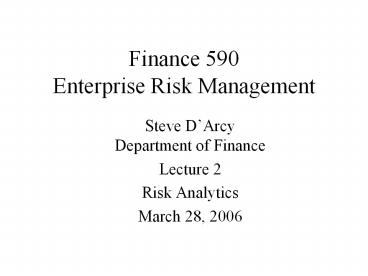Finance 590 Enterprise Risk Management PowerPoint PPT Presentation
1 / 26
Title: Finance 590 Enterprise Risk Management
1
Finance 590Enterprise Risk Management
- Steve DArcyDepartment of Finance
- Lecture 2
- Risk Analytics
- March 28, 2006
2
Reference Material
- Chapters 8 and 9 Enterprise Risk Management by
Lam - Overview of Enterprise Risk Management by the
Casualty Actuarial Society - http//www.casact.org/research/erm/overview.pdf
- Risk and Insurance by Anderson and Brown
- http//www.soa.org/ccm/cms-service/stream/asset/?a
sset_id8027034
3
Overview
- Risk Control Analytics
- Risk Optimization Analytics
- Classification of Risk Types
- Risk Analytics by Risk Type
- Performance Measures
- Risk Measures
- Risk Modeling
- Risk Integration
- Characteristics of Hazard Risk
- Insurance Terminology
4
Risk Control Analytics
- Scenario Analysis
- Stress testing
- Simulation
- Economic Capital
- Solvency standards
- Risk Indicators
- External
- Internal
5
Risk Optimization Analytics
- Return on Capital (Financial Services Industry)
- Risk-adjusted return on capital (RAROC)
- Return on risk-adjusted capital (RORAC)
- Risk-adjusted return on risk-adjusted capital
(RARORAC) - Economic Income Created
- Risk-adjusted return (Hurdle rate x economic
capital) - Shareholder Value
- Shareholder value (SHV)
- Shareholder value added (SVA)
6
Risk Types
- Hazard or Insurance Risk
- Financial or Market Risk
- Credit Risk
- Operational Risk
- Strategic Risk
7
Hazard Risk Management Analytics
- Probable Maximum Loss (PML)
- Maximum Possible Loss (MPL)
- Loss Frequency
- Loss Severity
- Actuarial Models
- Loss Distributions
8
Financial Risk Management Analytics
- Interest Rate Models
- Equilibrium models
- Arbitrage free models
- Value-at-Risk (VaR)
- Parametric
- Monte Carlo simulation
- Historical simulation
- Asset/Liability Management (ALM)
9
Credit Risk Analytics
- Credit Scoring Models
- Credit Migration Models
- Credit Exposure Models
- Credit Portfolio Models
- Financial models
- Econometric models
- Actuarial models
10
Operational and Strategic Risk Analytics
- Top-Down Approaches
- Analogs
- Historical loss data
- Bottom-Up Approaches
- Self assessment
- Cash flow model
11
Performance MeasuresGeneral
- Return on Equity (ROE)
- Operating Earnings
- Earnings before interest, dividends, taxes,
depreciation and amortization (EBITDA) - Cash Flow Return on Investments (CFROI)
- Weighted Average Cost of Capital (WACC)
- Economic Value Added (EVA)
12
Performance MeasuresInsurance Industry
- Economic Capital
- RAROC
- Expected net income divided by economic capital
- Embedded value
- Risk Based Capital (RBC)
13
Risk MeasuresSolvency Related
- Probability of Ruin
- Shortfall Risk
- Value-at-Risk (VaR)
- Expected Policyholder Deficit (EPD) or Economic
Cost of Ruin (ECOR) - Tail Value at Risk (Tail VaR) or Tail Conditional
Expectation (TCE) - Tail Events
14
Risk MeasuresPerformance Related
- Variance
- Standard Deviation
- Semi-variance and Downside Standard Deviation
- Below-target-risk (BTW)
15
Risk Modeling
- Analytic Methods
- Simulation Methods
- Statistical Methods
- Structural Methods
- Dynamic Financial Analysis (DFA)
16
Risk Integration
- Covariance
- Covariance Matrix
- Structural Simulation Model
17
Characteristics of Hazard Risk
- Loss/no loss situations (pure risk)
- Independence of individual exposures
- Important for risk to be insurable
- Types of hazard risk
- Persons
- Property
- Liability
18
Insurance Terminology
- Exposures
- Deductibles or retentions
- Policy limits
- Coinsurance
- Claims or losses
- Incurred
- Paid
- Loss adjustment expenses
- Loss frequency and severity
- Triggers
19
Alternative Risk Transfer (ART) Terminology
- Captives
- Finite insurance or reinsurance
- Insurance-linked bonds
- Insurance securitization
- Cat-E-Puts (Catastrophe equity put options)
- Contingent surplus notes
20
Loss Frequency
- Number of losses during policy period
- Often modeled as a Poisson distribution
- Pr(k) e-??k/k!
- where Pr probability
- k number of claims per year (0,1,2,...)
- ? expected number of claims per year
21
Loss Severity
- Size of loss given a loss has occurred
- Variety of potential severity distributions
- Empirical
- Exponential (Gamma)
- Lognormal
- Pareto
- Distribution characteristics
- Non-negative
- Positively skewed
- Variance positively correlated with mean
22
Hazard Risk Example
- Assume independent losses
- Loss frequency
- 0 80
- 1 15
- 2 5
- Loss severity
- 1,000 40
- 10,000 30
- 25,000 20
- 100,000 10
23
Hazard Risk Example (2)
24
Analysis of Potential Losses
- Expected losses 4,600
- Maximum possible loss 200,000
- Maximum probable loss (0.25) 125,000
- Expected losses excess of a 100,000 retention
1,084
25
Current State of Hazard Risk Management
- Insurance industry has developed a high level of
mathematical sophistication for valuing hazard
risks - Alternative market has also developed for dealing
with hazard risks - Key questions for organizations involve amount of
risk to retain (deductible) and how much coverage
to purchase (policy limits) - These questions begin to tie hazard risk into
enterprise risk management
26
Conclusion
- There is a standard approach for dealing with
each type of risk - Each area has its own terminology and techniques
- The ERM challenge is to combine these different
approaches into a common method that can deal
with risk in an integrated manner - The first step is to understand the different
approaches

